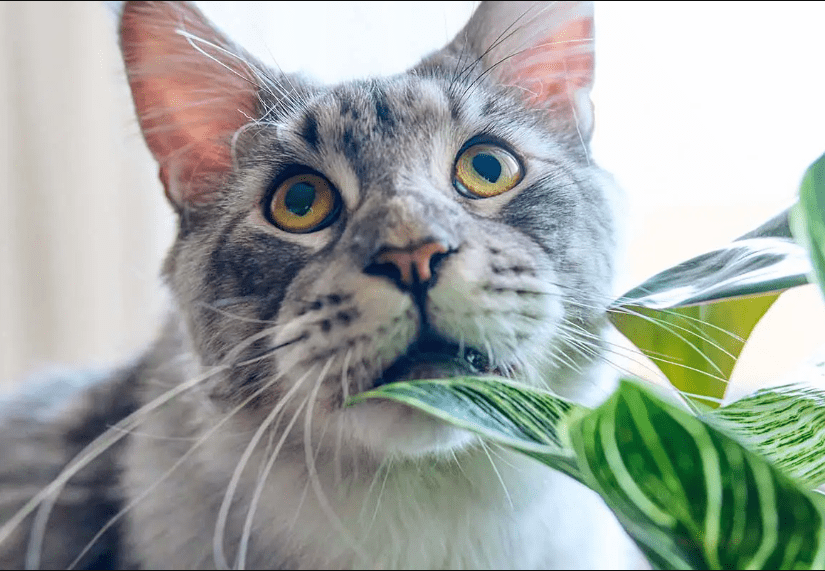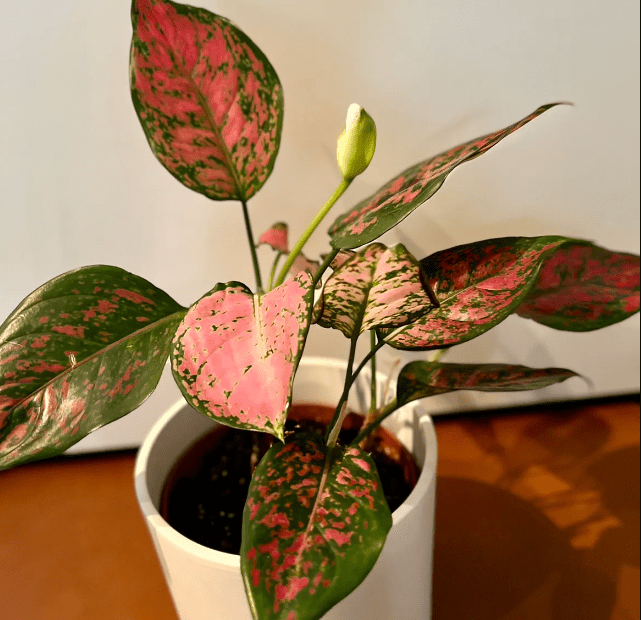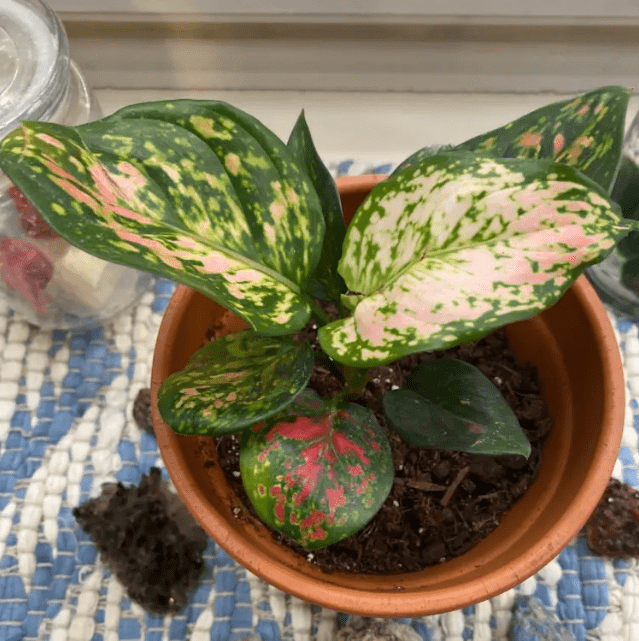Aglaonema is one of the attractive, common houseplants that can be highly toxic to cats. Many of us ask, “Is aglaonema toxic to cats?” This is an important plant to understand any potential risks it may pose to our cats.
Knowing the hidden dangers within our living space is the important thing as we deep dive into the world of aglaonema toxicity and how it affects cats. How does this ornamental plant affect our beloved pets, and what steps can be taken to keep them healthy against this impending threat?
Understanding Aglaonema Toxicity
Aglaonema or Chinese evergreen is one of the popular ornamental indoor plants. As a pet owner, however, it should get your concern that aglaonema when ingested is toxic to cats. Understanding toxicity caused by aglaonema will lead to the well-being of your feline companions.
The plahttps://houseofplants.biz.id/nt contains calcium oxalate crystals that are poorly soluble and, when taken up by a cat, can cause irritation and swelling of the mouth, throat, and gastrointestinal tract. Clinical signs of toxicity from aglaonema ingestion in cats include excessive salivation, dysphagia, emesis, and dyspnea if severe. If you suspect your cat has had contact with or ingested aglaonema, take immediate action.
Aglaonema toxicity can range from mild to severe, based on the quantity consumed and the sensitivity of the individual cat. If your cat shows any of the following signs after being exposed to aglaonema, consult with a veterinarian right away. The safest way to care for your pets is through prevention; thus, it is recommended that poisonous plants, like aglaonema, be inaccessible to cats to prevent any danger.
It is, therefore, very important for any responsible owner of a pet to be aware of the toxicity that aglaonema can cause to cats. By understanding what kind of risk this plant may be to them and by taking measures in advance to avoid exposure, a pet owner can provide a safe environment for their felines.

Effects of Aglaonema Ingestion on Cats
If a cat ingests an aglaonema, there may be severe internal damages and risks involved. Aglaonema has toxic elements, which may lead to inducing vomiting, drooling, and difficulty in swallowing due to toxic saliva and gastrointestinal upset. Renal failure or respiratory problems caused by the toxin of the plant upon the body may occur as a result of ingestion of this plant.
Aglaonema, if ingested, can cause an allergic reaction in cats manifested through skin irritation, swelling, or itching. They also tend to exhibit changes in behavior; some become lethargic, others disoriented, while some drool excessively. What is important is that the moment you begin to suspect that your cat has ingested aglaonema, you need to closely monitor it and rush it immediately to a veterinary doctor.
The range of effects that aglaonema is capable of inducing in cats includes anything from mild symptoms to life-threatening conditions. Because of this, understanding the risk and intervening right away upon any incidents of plant ingestion greatly improves your cat’s chances of recovery. This can only be done with some prevention and creating a safe environment for your pet away from the toxicity of aglaonema.
Internal Damage and Risks
Various internal damages and risks can rise when cats eat parts of the aglaonema plant. These toxic elements of aglaonema also cause various gastrointestinal problems, which may include vomiting, diarrhea, abdominal pain, amongst other such issues. Potential liver and kidney damage of the cat also occurs through the intake of this toxic plant.
Besides this, the irritating effects of aglaonema on the cat’s mouth, throat, and digestive tract will enhance the internal damage due to inflammation and discomfort. If left unmediated, in acute conditions, the toxic elements of aglaonema can even cause organ failure and hence create a huge threat to the overall health and well-being of the cat.
These are the internal risks from aglaonema toxicity that one should be concerned about being a cat owner; hence, such instances of ingestion should be immediately addressed with attention and care by a veterinary expert. The sooner the intervention, the better it would be to reduce the toxic effects of the plant inside and increase the chances of a good prognosis for one’s cherished feline friend. Preventive measures would also be very key in safeguarding one’s feline friend against such risks by keeping the aglaonema out of the cat’s reach.
Allergic Reactions and Behavioral Changes
The aglaonema plant may be ingested by cats to show allergic reactions and behavioral changes. The skin may also indicate an allergic reaction through irritation, itching, or swelling as a way of detaching the plant’s poisons from the cat’s body. Cats may indicate changes in behavior such as restlessness, increased sleeping, and loss of appetite after ingestion of the plant.
You will be required to monitor your cat for a certain period of time for any allergic reactions or changes in behavior upon ingesting aglaonema. In case you feel that something is out of the ordinary, get veterinary advice right away. Allergic reactions can quickly worsen, and changes in behavior may signify pain or poisoning that may need immediate intervention by the pros for your pet not to suffer.
It is necessary to understand the possible allergic reactions and changes in behavior that cats will undergo due to aglaonema ingestion for on-time interference. Always be watchful and proactive about the condition of your pet to minimize the danger of plant toxicity. Protect your pet by being sensitive to signs of unusual symptoms, taking advice on time from a veterinarian, and carrying out proper treatment.

Steps to Be Taken Immediately After Your Cat Has Ingested Aglaonema
This is pretty much an emergency when one’s cat ingests Aglaonema. The following procedure is what the owner should do in order to efficiently act on such an occurrence:
- Determine Circumstances: Estimate the amount ingested and observe your cat for sudden adverse reactions.
- Call Your Vet: Contact your vet or an emergency animal poison control hotline for further instruction.
- Do Not Try to Vomit: Unlike other types of poisons, attempting to make your cat vomit can be extremely perilous. This should only be performed by a professional.
- Prepare Applicable Information: Be prepared to provide information such as amount and time of intake of the substance, current symptoms your cat is displaying, and any previous disorders your cat has had, which will aid the veterinarian in assessing the situation correctly.
Long-Term Care following Exposure to Aglaonema
Following exposure to aglaonema, your cat should be monitored constantly. Follow up with your veterinarian for consultations and analysis regarding the possibility of long-term effects. Give your cat plenty of water and nutritional food to assist in the recovery process. Relieve any remaining symptoms promptly to avoid complications.
Create a safe environment by removing access to the aglaonema plants, along with any other toxic materials. Enhance your cat’s indoor space by incorporating plants that are non-toxic to cats, like spider plants or catnip. Physically and psychologically, recovery from poisoning can be assisted by creating a diverse environment through the use of multiple toys and scratching posts. For quicker recovery, keep your cat as comfortable and safe as possible.
Thirdly, this is where you should establish a routine for your cat regarding playtime and exercise, which is important in maintaining its physical health. You can engage in some interactive activities that strengthen bonds, reducing stress brought about by the previous exposure. Therefore, ensure that you have enriching experiences that challenge your cat’s sensory abilities and cognitions. Consistent care and attention are important in bringing your cat through the recovery process and ensuring quality of life.
Preventive Measures for Pet Owners
The following will help you take care of your feline pets and keep them safe from the looming Aglaonema toxicity:
- Keep Aglaonema out of reach: All Aglaonema plants should be kept on top shelves, hanging baskets, or basically out of reach of cats and puppies.
- Educate Yourself and Others: Learn about the toxic effects Aglaonema has on cats, and inform family members and housemates to make sure everyone is aware of the risks.
- Offer Alternatives: Replace with cat-friendly plants, such as catnip or cat grass, which will help distract your pet’s interest from potentially harmful foliage.
- See a Veterinarian: If you feel that your cat has ingested an Aglaonema or any other toxic plant, seek immediate veterinary help for diagnosis and proper treatment.

Conclusion: Keeping Cats Safe from Aglaonema Toxicity
In this regard, keeping cats from Aglaonema toxicity requires alertness as a responsible pet owner. It’s best to keep your cats away from toxic plants like Aglaonema. Regularly check your house for any flora that might be dangerous to your pet. Educate yourself regarding the symptoms of plant poisoning with cats, and have the contact information for emergency access ready should ingestion occur. One must seek help immediately if symptoms show up in your cat after exposure.
Also, consult your veterinarian for a list of non-toxic plants that are safe to have around your home environment. You can substitute toxic plants with cat-friendly greenery. You can teach your cat not to be interested in the plants so as to prevent accidental ingestion. Secure your cat from accidental poisoning by removing toxic hazards like Aglaonema from its reach.
Remember, prevention is the best protection the felines get from plant toxicity. Your proactiveness and knowledge will help you provide your pets with a nontoxic, safe living environment. Be always cautious and observant of the things around your cat to avoid any incidence related to plants. It all begins with being watchful and responsible in taking care of your cat to keep it safe from Aglaonema toxicity.
It therefore behooves the owners to be responsible for the awareness of possible Aglaonema toxicity in cats. This calls for immediate action, from the instance of exposure, for a period thereafter, to ensure longevity in their cats. By being proactive with some prevention steps and immediate veterinary intervention when required, pet owners are better assured of a safe environment for their feline companions.